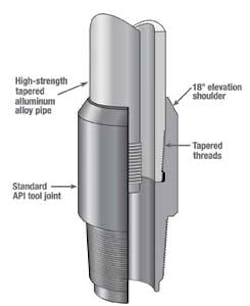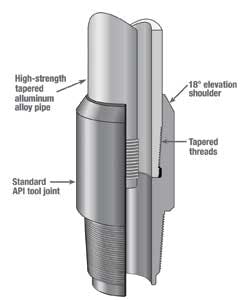Extended-reach drilling systems address downhole challenges
Don Francis
Special Correspondent
In the upstream oil and gas industry, record-setting performances of various sorts are frequently touted. But, because of the interlocking nature of all the components of this highly complex enterprise, it is difficult to ascribe success exclusively to just one part.
Achievements of systems—in this case, drilling systems—are easier to measure. Things like footage drilled over time are important, of course, but one metric in particular is arguably the most important of them all: reservoir exposure to a single wellbore.
Extended-reach drilling (ERD) has been around for many years, but the tempo of technical developments is quickening in response to the ever-growing challenges the industry faces in a world where the "easy oil" has already been found.
ERD shines in maximizing reservoir exposure in a single wellbore. The definition of "extended-reach drilling" is not set in cement, but many consider it asdrilling a well with horizontal displacement at least twice the true vertical depth.
Other definitions of ERD wells include wells having horizontal displacements greater than twice the true vertical depth, yielding inclination angles exceeding 63.4°; wells that approach the limits of achieved by the industry in terms of horizontal displacement; and high-angle directional wells that approach the capabilities of the contracted rig.
A degree of difficulty is also involved. Generally, shallower reserves are more difficult to access by ERD methods.
Typically, the ERD limit is reached when one or more of the following occurs:
- The hole becomes unstable, due either to time exposure, geomechanical interaction, adverse pressure differential, or drilling fluids interaction (or incompatibility). The onset of these conditions usually results in the sudden increase of torque and drag in the drillstring not related to dogleg severity (DLS) of the hole or the length of the drilled section.
- The drillstring no longer travels to the bottom of the hole due to excessive drag. This is differentiated from the preceding in that this effect is not related to the friction factor, which remains unchanged. Instead, it is related to the cumulative length drilled along with the DLS of the hole as drilled.
- When rotation is used to overcome friction and advance the drillstring, such as in rotary steerable application. The limit is reached when you reach the torque capacity of the tubulars.
The most often-cited purposes of ERD are to reach a larger area from one surface drilling location, keep a well in a reservoir for a longer distance in order to maximize its productivity and drainage capability, and/or drill and produce the reservoir from a remote location, to avoid hazards.
With these advantages come challenges. One of the most fundamental is mechanical loads on the drillstring, an area where nontraditional materials and new ideas are showing promising results. Hole cleaning and managing downhole pressure are also critical, and new ideas are addressing these problems as well.
Other important technologies include the use ofrotary steerable systems (RSS), measurement-while-drilling (MWD), and logging-while-drilling (LWD) tools. It is not an overstatement to say these technologies make ERD possible.
(Image courtesy Alcoa Oil and Gas)
Well planning considerations
For some ER wells, careful well planning and existing drilling practices are sufficient to avoid problems such as wellbore instability, lost circulation, and stuck pipe. However, results from several studies show that when well step-out ratios increase, some operational practices developed while drilling conventional wells become inadequate to cost effectively deliver the ER wells. Careful planning alone cannot always prevent drilling problems.
ERD well profile design is not a simple geometric curve. It is an integrated process that requires an optimum well path profile with respect to torque and drag. Two main principles should be obeyed when planning an extended-reach well: minimizing torque and drag, and minimizing well length.
McClendon and Anders (1985) described the use of the catenary well plan method for directional drilling. A modified version of this method was used with success to drill some early ERD and horizontal wells in the North Sea's Statfjord field. The method was mainly used to reduce torque and drag by reducing the wall forces in the build-up section. This was done in the top part of the hole where the drill pipe tension and side loads were highest.
As is the case with all drilling operations, detailed engineering preplanning is critical to successfully drill ERD wells. It is crucial to be able to accurately predict the following parameters under actual downhole conditions:
- Static and dynamic temperature profiles in the well
- Hydraulic pressures
- Annular pressure loss
- Equivalent circulation density
- Mud rheology.
Displaying 1/3 Page 1,2, 3Next>
View Article as Single page

